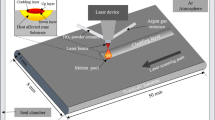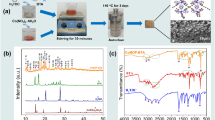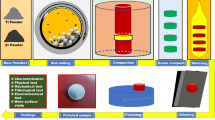Abstract
This paper presents a new approach to modify the surface of the Ti–6Al–4V alloy fabricated by additive manufacturing. This method is particularly suitable for titanium or titanium alloy components with complex shapes (such as pipes, holes and internal flow paths) which are difficult to be polished by conventional methods. The corresponding electrochemical tests were carried out in Hanks’ balanced salt solution. The results demonstrated that the chemical polishing of additively manufactured Ti–6Al–4V obtained a high-quality surface through the combination of oxidation corrosive action and polishing liquid flow by reducing the peak-to-valley spacing and smoothing the alloy surface. After chemical polishing, a passivation film consisted of rutile and anatase formed on the alloy surface, which showed n-type semiconductor characteristics and had a lower donor density, leading to the increase in the corrosion resistance.








Similar content being viewed by others
References
Frazier WE (2014) Metal additive manufacturing: a review. J Mater Eng Perform 23:1917–1928
Melchels FPW, Domingos MAN, Klein TJ, Malda J, Bartolo PJ, Hutmacher DW (2012) Additive manufacturing of tissues and organs. Prog Polym Sci 37:1079–1104
Gong HJ, Rafi K, Gu HF, Ram GDJ, Starr T, Stucker B (2015) Influence of defects on mechanical properties of Ti–6Al–4V components produced by selective laser melting and electron beam melting. Mater Des 86:545–554
Zhao BJ, Wang H, Qiao N, Wang C, Hu M (2017) Corrosion resistance characteristics of a Ti–6Al–4V alloy scaffold that is fabricated by electron beam melting. Mater Sci Eng, C 70:832–841
Browne M, Gregson PJ (1994) Surface modification of titanium alloy implants. Biomater 15:894–898
Rie KT, Lampe T (1985) Thermochemical surface treatment of titanium and titanium alloy Ti–6Al–4V by low energy nitrogen ion bombardment. Mater Sci Eng 69:473–481
Gong XJ, Cui YJ, Wei DX, Liu B, Liu RP, Nie Y, Li YP (2017) Building direction dependence of corrosion resistance property of Ti–6Al–4V alloy fabricated by electron beam melting. Corros Sci 127:101–109
Liu XY, Chu PK, Ding CX (2004) Surface modification of titanium, titanium alloys, and related materials for biomedical applications. Mater Sci Eng 47:49–121
Szymczyk P, Junka A, Ziółkowski G, Bartoszewicz M, Chlebus E (2013) The ability of S. aureus to form biofilm on the Ti–6Al–7Nb scaffolds produced by selective laser melting and subjected to the different types of surface modifications. Acta Bioeng Biomech 15:69–76
Zhang L, Yuan AM, Qi ZJ, Cai QH, Cheng ZC, Qi H (2018) CFD-based study of the abrasive flow characteristics within constrained flow passage in polishing of complex titanium alloy surfaces. Powder Technol 333:209–218
Nagano H, Kajimura H, Yamanaka K (1995) Corrosion resistance of zirconium and zirconium-titanium alloy in hot nitric acid. Mater Sci Eng, A 198:127–134
Shah UH, Rahman Z, Deen KM, Asgar H, Shabib I, Haider W (2017) Investigation of the formation mechanism of titanium oxide nanotubes and its electrochemical evaluation. J Appl Electrochem 47:1147–1159
Ozdemir Z, Ozdemir A, Basim GB (2016) Application of chemical mechanical polishing process on titanium based implants. Mater Sci Eng C 68:383–396
Shimpo H (2008) Effect of arm design and chemical polishing on retentive force of cast titanium alloy clasps. J Prosthodont 17:300–307
Zhang ZY, Shi ZF, Dua YF, Yu ZJ, Li C, Guo DM (2018) A novel approach of chemical mechanical polishing for a titanium alloy using an environment-friendly slurry. Appl Surf Sci 427:409–415
Łyczkowska E, Szymczyk P, Dybała B, Chlebus E (2014) Chemical polishing of scaffolds made of Ti–6Al–7Nb alloy by additive manufacturing. Arch Civil Mech Eng 14:586–594
Kaushik RM, Bhandakkar AB, Patro TU (2014) Solution of emulsifiable oil and hydrogen peroxide for chemical-mechanical polishing of Ti alloy-A green approach. Mater Lett 122:252–255
Cheng T, Chen Y, Nie X (2013) Surface morphology manipulation and wear property of bioceramic oxide coatings on titanium alloy. Surf Coat Technol 215:253–259
Advincula MC, Petersen D, Rahemtulla F, Advincula R, Lemons JE (2007) Surface analysis and biocorrosion properties of nanostructured surface sol-gel coatings on Ti–6Al–4V titanium alloy implants. J Biomed Mater Res B Appl Biomater 80:107–120
Tomashov ND, Chernova GP, Ruscol YS, Ayuyan GA (1997) The passivation of alloys on titanium bases. Electrochim Acta 19:159–172
Mohan L, Anandan C, Grips VKW (2012) Corrosion behavior of titanium alloy Beta-21S coated with diamond like carbon in Hank’s solution. Appl Surf Sci 258:6331–6340
Klein N, Yarnitzky C (1980) Conductometric determination of the uncompensated resistance in a three-electrode system. Anal Chem 52:998–999
Kwon Y, Kim H, Lee S, Chin I, Seong T, Lee W, Lee C (2012) Enhanced ethanol sensing properties of TiO2 nanotube sensors. Sens Actuators, B 173:441–446
Asgari V, Noormohammadi M, Ramazania A, Kashi MA (2018) A new approach to electropolishing of pure Ti foil in acidic solution at room temperature for the formation of ordered and long TiO2 nanotube arrays. Corros Sci 136:38–46
Bonu V, Das A, Sivadasan AK, Tyagi AK, Dhara S (2015) Invoking forbidden modes in SnO2 nanoparticles using tip enhanced Raman spectroscopy. J Raman Spectrosc 49:1037–1040
Regonini D, Jaroenworaluck A, Stevensa R, Bowena CR (2010) Effect of heat treatment on the properties and structure of TiO2 nanotubes: phase composition and chemical composition. Surf Interface Anal 42:139–144
Ohsaka T, Izumi F, Fujiki Y (1978) Raman spectrum of anatase, TiO2. J Raman Spectrosc 7:321–324
Zhang YF, Li JZ, Che SH (2018) Electropolishing mechanism of Ti–6Al–4V alloy fabricated by selective laser melting. Int J Electrochem Sci 13:4792–4807
Dzhurinskiy D, Gaob Y, Yeung WK, Strumban E, Leshchinsky V (2015) Characterization and corrosion evaluation of TiO2: n-HA coatings on titanium alloy formed by plasma electrolytic oxidation. Surf Coat Technol 269:258–265
Rammelt U, Reinhard G (1990) On the applicability of a constant phase element (CPE) to the estimation of roughness of solid metal electrodes. Electrochim Acta 35:1045–1049
Adam S, Elzbieta F (2018) Determination of accurate electrode contribution during voltammetry scan of electrochemical capacitors. J Solid State Electrochem 22:2135–2139
Heakal FE, Ghoneim AA, Mogoda AS, Awad KH (2011) Electrochemical behavior of Ti–6Al–4V alloy and Ti in azide and halide solutions. Corros Sci 53:2728–2737
López MF, Gutierrez A, Jimenez JA (2002) In vitro corrosion behaviour of titanium alloys without vanadium. Electrochim Acta 47:1359–1364
Hirschorn B, Orazem ME, Tribollet B, Vivier V, Frateur I, Musiani M (2010) Determination of effective capacitance and film thickness from constant-phase-element parameters. Electrochim Acta 55:6218–6227
Brug GJ, Eeden ALG, Sluyters-Rehbach M, Sluyters JH (1984) The analysis of electrode impedances complicated by the presence of a constant phase element. J Electroanal Chem Interfacial Electrochem 176:275–295
Yang I, Kim SG, Kwon SH, Kim MS, Jung JC (2017) Relationships between pore size and charge transfer resistance of carbon aerogels for organic electric double-layer capacitor electrodes. Electrochim Acta 223:21–30
Liu JH, Yu Q, Yu M, Li SM, Zhao K, Xue B, Zu H (2018) Silane modification of titanium dioxide-decorated graphene oxide nanocomposite for enhancing anticorrosion performance of epoxy coatings on AA-2024. J Alloys Compd 774:728–739
Ismail KM, Fathy AM, Badawy WA (2004) The influence of Ni content on the stability of copper–nickel alloys in alkaline sulphate solutions. J Appl Electrochem 34:823–883
Brunette DM, Tengvall P, Textor M, Thomsen P (2001) Properties and biological significance of natural oxide films on titanium and its alloys. Springer, Berlin
Hayre RO, Nanu M, Schoonman J, Goossens A (2007) Mott − Schottky and charge-transport analysis of nanoporous titanium dioxide films in air. J Phys Chem C 111:4809–4814
Zhang GA, Cheng YF (2009) Micro-electrochemical characterization and Mott–Schottky analysis of corrosion of welded X70 pipeline steel in carbonate/bicarbonate solution. Electrochim Acta 55:316–324
Ahn SJ, Kwon HS (2004) Effects of solution temperature on electronic properties of passive film formed on Fe in pH 8.5 borate buffer solution. Electrochim Acta 49:3347–3353
Sanchez-Tovar R, Fernandez-Domene RM, García-García DM, García-Anton J (2015) Enhancement of photoelectrochemical activity for water splitting by controlling hydrodynamic conditions on titanium anodization. J Power Sources 286:224–231
Aïnouche L, Hamadou L, Kadri A, Benbrahim N, Bradai D (2014) Interfacial barrier layer properties of three generations of TiO2 nanotube arrays. Electrochim Acta 133:597–609
Babilas D, Urbnczyka E, Sowa M, Maciej A, Korotin DM (2016) On the electropolishing and anodic oxidation of Ti–15Mo alloy. Electrochim Acta 205:256–265
Sowa W, Greń K, Kukharenko AI, Korotin DM, Michalska J (2014) Influence of electropolishing and anodic oxidation on morphology, chemical composition and corrosion resistance of niobium. Mater Sci Eng, C 42:529–537
Heakal FE, Ghoneim AA, Mogoda AS, Awad K (2011) Electrochemical behaviour of Ti–6Al–4V alloy and Ti in azide and halide solutions. Corros Sci 53:2728–2737
Sepúlveda M, Quintero D, Castaño JG, Echeverría F (2018) Improved two-step Brytal process for electropolishing of aluminum alloys. Corros Sci 136:386–392
Acknowledgements
This work was supported by the Iron and Steel Joint Research Found of National Natural Science Foundation and China Baowu Steel Group Corporation Limited (Grant Number U1760118); and the National Natural Science Foundation of China (Grant Number 51374053).
Author information
Authors and Affiliations
Corresponding author
Additional information
Publisher's Note
Springer Nature remains neutral with regard to jurisdictional claims in published maps and institutional affiliations.
Rights and permissions
About this article
Cite this article
Zhang, Y., Li, J., Che, S. et al. Chemical leveling mechanism and oxide film properties of additively manufactured Ti–6Al–4V alloy. J Mater Sci 54, 13753–13766 (2019). https://doi.org/10.1007/s10853-019-03855-4
Received:
Accepted:
Published:
Issue Date:
DOI: https://doi.org/10.1007/s10853-019-03855-4




